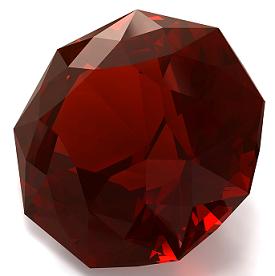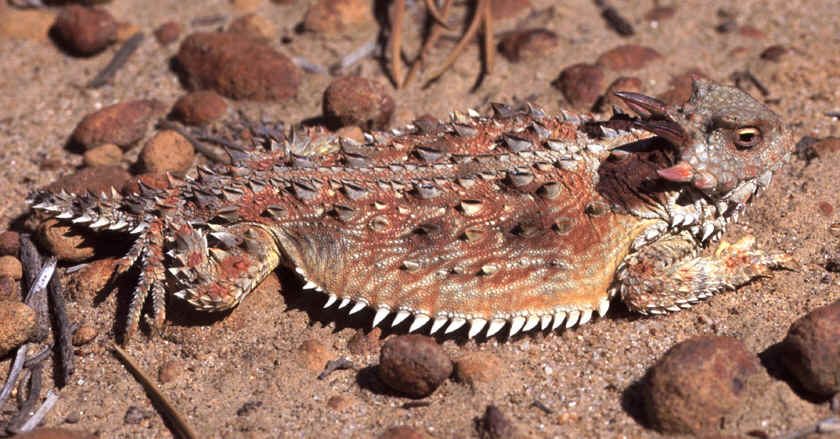
Hey this is Matthew with gemstone of the week! Previously, the gemstone of the week was watermelon tourmaline. Now, the gemstone of the week is...... garnet! Garnet is the birthstone of January. To start it off, garnet is the name of a family of different types of minerals, and got its name from the pomegranate fruit. The minerals that make up garnet are almandine, pyrope, spessartine, grossular, and andradite. Because of their chemical difference, garnets can be made in most different colors other than blue, but they're mostly found shades of red. They are mostly found in Czechoslovakia, South Africa, USA, Australia, Brazil, and Sri Lanka. First, pyrope garnet was most popular in the 19th century, with a deep-red garnet. Spessartine garnet contains marvelous orange colors, and is often in jewelry. Different stones contain different shapes, and they have names for them. Almandine garnet crystallizes as icositetrahedrons. But the unique thing about these garnets is that they have a really deep color, but are transparent! Geology can be very different, especially with garnets! Andradite garnet can never be crystallized as gem-quality, or in jewelry. And finally, there is grossular garnets. It is said to look like gooseberries, and its name, grossular, came from the Latin word for gooseberry- grossularia. This is the wonderful world of garnets! Thank you for reading! Here's a picture of a garnet.








 Hey this is Matthew with gemstone of the week! Previously, the gemstone of the week was watermelon tourmaline. Now, the gemstone of the week is...... garnet! Garnet is the birthstone of January. To start it off, garnet is the name of a family of different types of minerals, and got its name from the pomegranate fruit. The minerals that make up garnet are almandine, pyrope, spessartine, grossular, and andradite. Because of their chemical difference, garnets can be made in most different colors other than blue, but they're mostly found shades of red. They are mostly found in Czechoslovakia, South Africa, USA, Australia, Brazil, and Sri Lanka. First, pyrope garnet was most popular in the 19th century, with a deep-red garnet. Spessartine garnet contains marvelous orange colors, and is often in jewelry. Different stones contain different shapes, and they have names for them. Almandine garnet crystallizes as icositetrahedrons. But the unique thing about these garnets is that they have a really deep color, but are transparent! Geology can be very different, especially with garnets! Andradite garnet can never be crystallized as gem-quality, or in jewelry. And finally, there is grossular garnets. It is said to look like gooseberries, and its name, grossular, came from the Latin word for gooseberry- grossularia. This is the wonderful world of garnets! Thank you for reading! Here's a picture of a garnet.
Hey this is Matthew with gemstone of the week! Previously, the gemstone of the week was watermelon tourmaline. Now, the gemstone of the week is...... garnet! Garnet is the birthstone of January. To start it off, garnet is the name of a family of different types of minerals, and got its name from the pomegranate fruit. The minerals that make up garnet are almandine, pyrope, spessartine, grossular, and andradite. Because of their chemical difference, garnets can be made in most different colors other than blue, but they're mostly found shades of red. They are mostly found in Czechoslovakia, South Africa, USA, Australia, Brazil, and Sri Lanka. First, pyrope garnet was most popular in the 19th century, with a deep-red garnet. Spessartine garnet contains marvelous orange colors, and is often in jewelry. Different stones contain different shapes, and they have names for them. Almandine garnet crystallizes as icositetrahedrons. But the unique thing about these garnets is that they have a really deep color, but are transparent! Geology can be very different, especially with garnets! Andradite garnet can never be crystallized as gem-quality, or in jewelry. And finally, there is grossular garnets. It is said to look like gooseberries, and its name, grossular, came from the Latin word for gooseberry- grossularia. This is the wonderful world of garnets! Thank you for reading! Here's a picture of a garnet.

 As you can see,on the map above, yosemite has water falls, rivers, trails, and is a blast of fun. I have been to Yosemite, the weather is nice, the air is fresh, and every where you look, you see beauty. Yosemtite has a neat museum, pioner history center, i could explode giving all the things to do.
As you can see,on the map above, yosemite has water falls, rivers, trails, and is a blast of fun. I have been to Yosemite, the weather is nice, the air is fresh, and every where you look, you see beauty. Yosemtite has a neat museum, pioner history center, i could explode giving all the things to do.  This ant is what looks like a sponge getting the water.
This ant is what looks like a sponge getting the water.
 This is what we cause, is a poor bear our on its own and has to swim as soon as that ice berg melts and will freeze. This is all from driving cars to much and burning oil which eventually creates the image above. Now they are highly endangered. They are the top of the food chain in the Arctic and if they aren't there then a whole bunch of things will be laying on the ground dead.
This is what we cause, is a poor bear our on its own and has to swim as soon as that ice berg melts and will freeze. This is all from driving cars to much and burning oil which eventually creates the image above. Now they are highly endangered. They are the top of the food chain in the Arctic and if they aren't there then a whole bunch of things will be laying on the ground dead.
 This is a food web that is really explained to who eats who. We stay alive from looking at the food pyramid. This is how other smaller thing stay alive. Its really amazing.
This is a food web that is really explained to who eats who. We stay alive from looking at the food pyramid. This is how other smaller thing stay alive. Its really amazing.